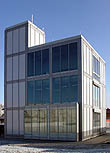Feb 13 2005

Everyone wants a pleasant atmosphere at work – literally. It should be neither too cold nor too damp. However, employee comfort must not consume too much power. Researchers are examining the energy efficiency of facades and comfort in rooms on a test building.
The low winter sun shines through the building’s glass front onto the computer monitor, making the text impossible to read. A sun blind, usually on the outside of the building, allows employees to shut out the bright light – but it also keeps out the sun’s warming light. Blinds on the inside, by contrast, shut out the glare but support the central heating. But how does the angle of the blinds affect the buildup of heat in the office in summer? How comfortable are the employees with this solution? Questions like these urgently need answers because office buildings will have to comply with European energy efficiency regulations from January 2006 onward. Architects and builders must design future buildings for optimum overall energy performance, with thermal insulation and a low-energy heating system. The electricity bill for lighting and air-conditioning must be kept low too.
Researchers at the Fraunhofer Institute for Building Physics IBP in Holzkirchen near Munich now plan to minimize the energy consumption of various building designs. The investigations include air conditioning, lighting and sun blinds, while enhancing comfort at the individual workplace. To do this, they have constructed a three-story test building, the VERU (modular test facility for energy and indoor environments). “We primarily examine the effects of different facade systems and service installations on the atmosphere in the rooms,” states Herbert Sinnesbichler, deputy head of department at the IBP. The researchers can remove walls, suspended ceilings and roof elements to simulate open-plan offices, galleried spaces or transparent roof sections. Their first large-scale experiment integrated more than 50 different technologies in the twelve test rooms. “We use over 250 sensors to detect energy flows, air humidity and speed, temperatures and light intensity,” explains the engineer. “And a dummy studded with numerous heatable sensors measures thermal comfort at the workplace.”
The project took off in September 2004, involving partners from such diverse industrial sectors as facade construction, solar protection systems, and heating and indoor environment engineering. The first meaningful results are expected by April.
For more information on facades, click here.